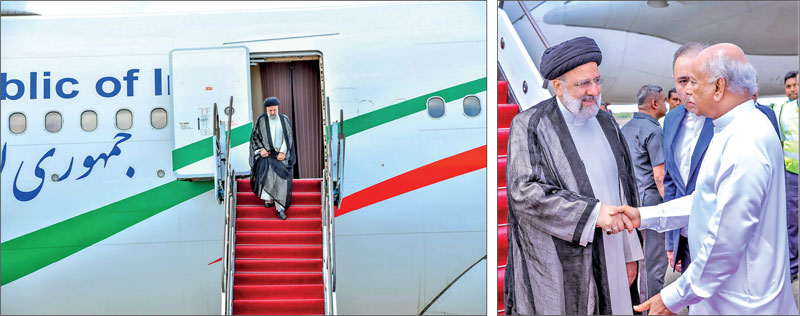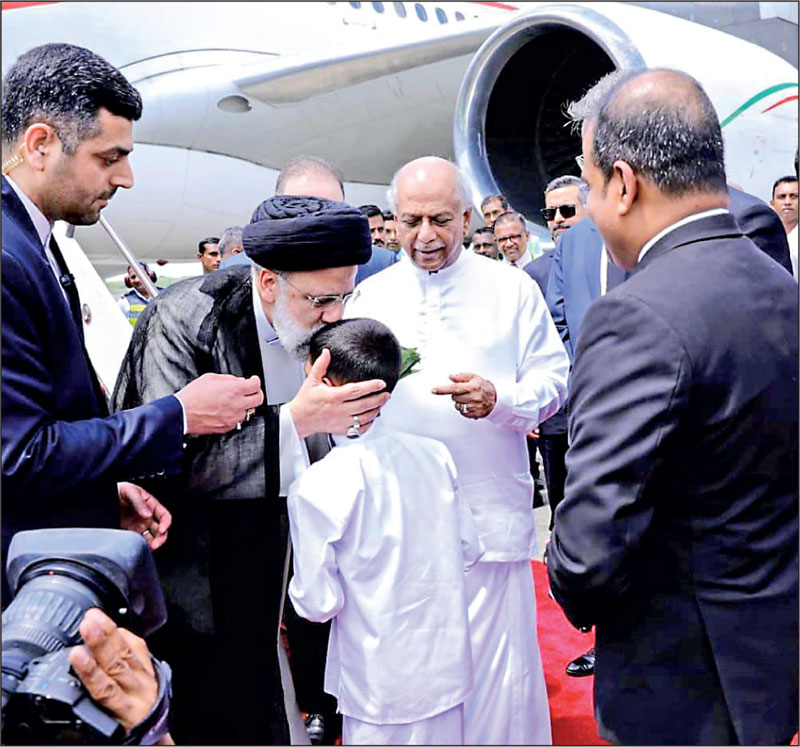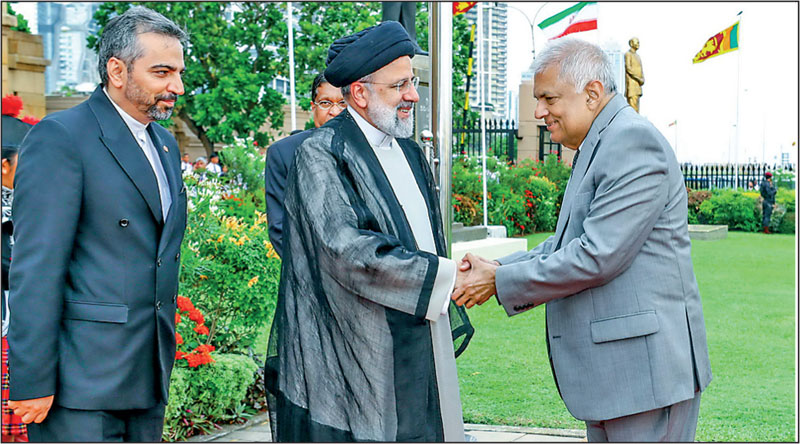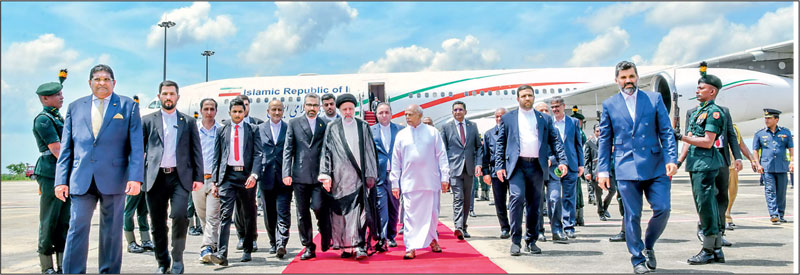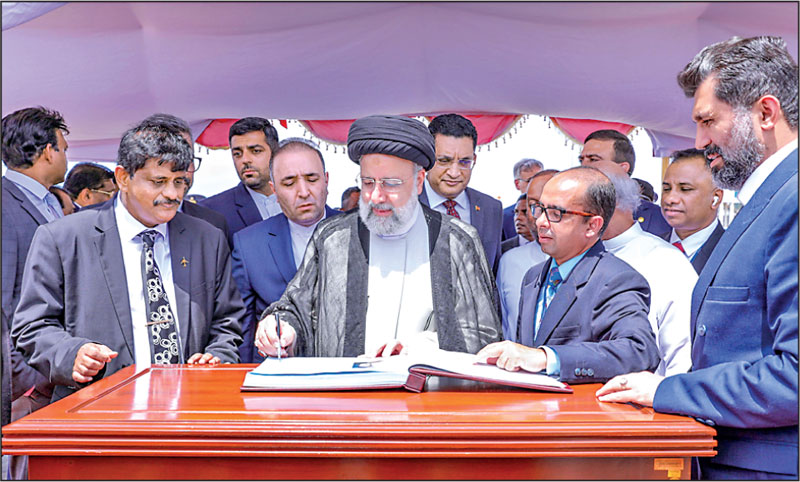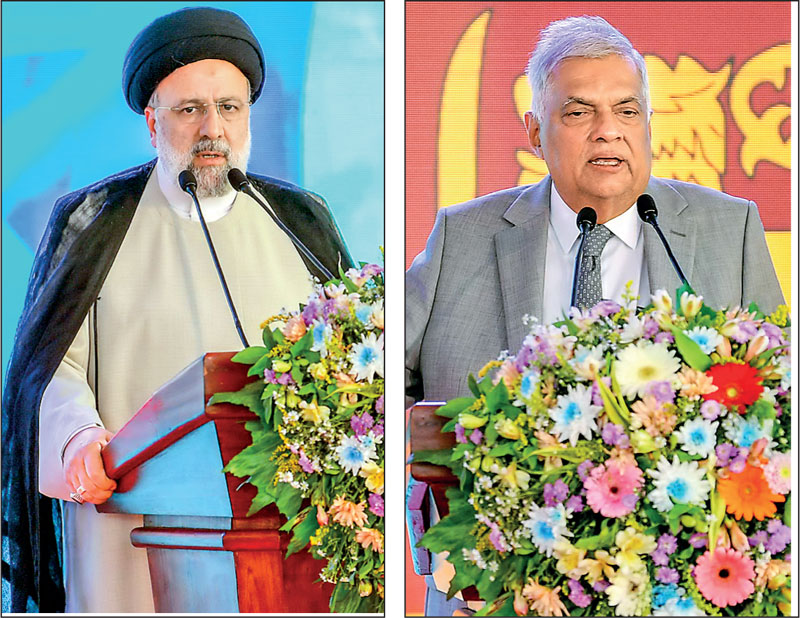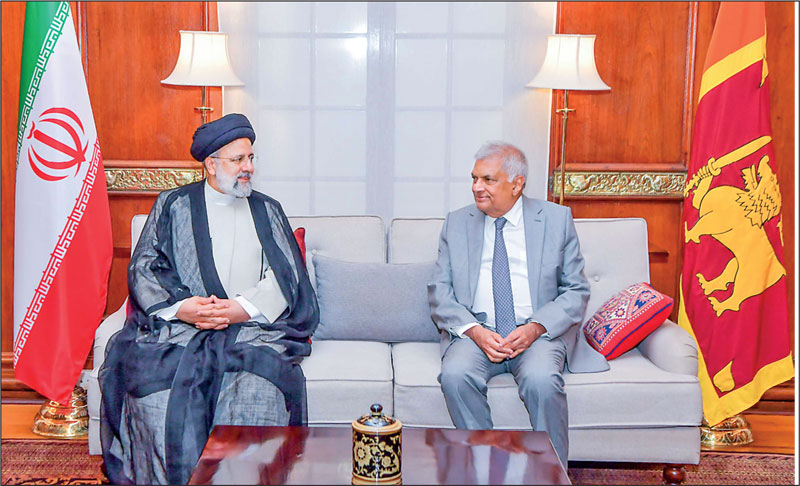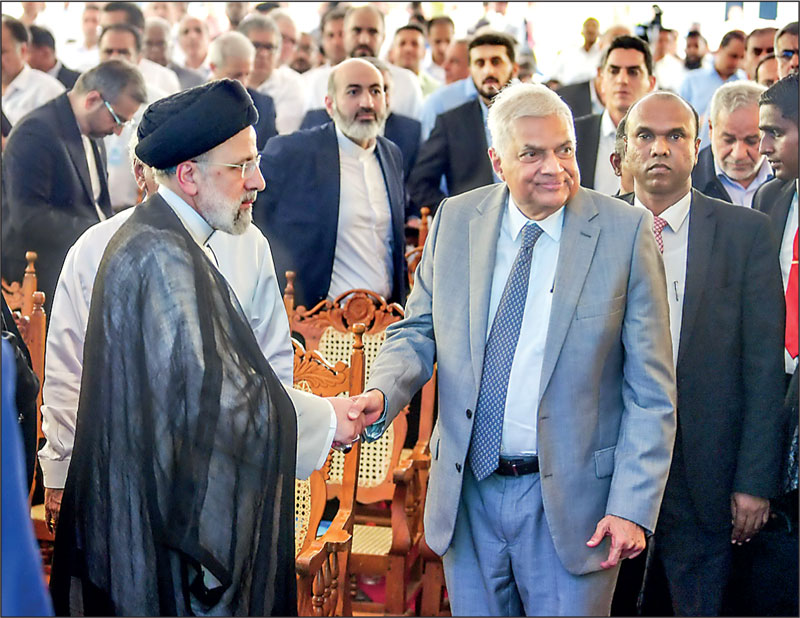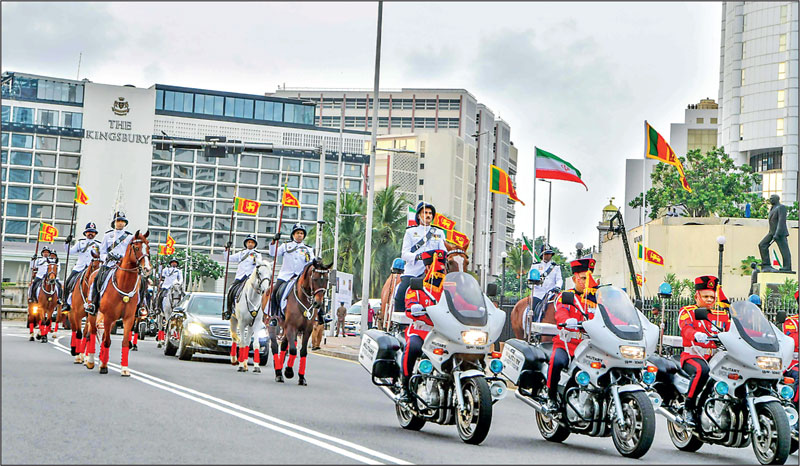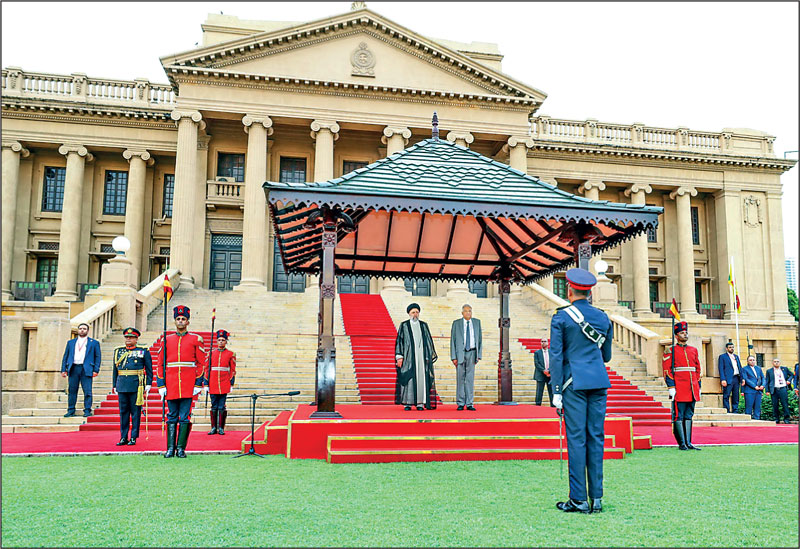Monday Apr 07, 2025
Monday Apr 07, 2025
Thursday, 25 April 2024 00:00 - - {{hitsCtrl.values.hits}}
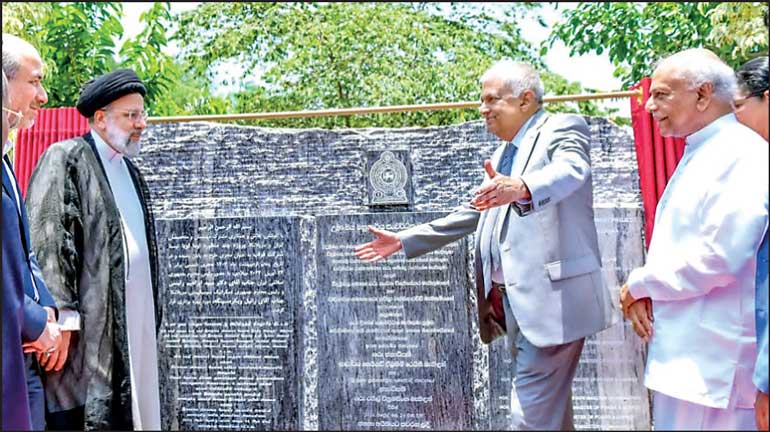
President Ranil Wickremesinghe gestures with open his arms to Iranian President Dr. Ibrahim Raisi at the opening of the $ 514 million Uma Diya Janani’ multi-purpose development project yesterday
In an internationally widely observed and landmark visit to Sri Lanka, the Iranian President Dr. Ibrahim Raisi yesterday renewed his country’s further support to the progress of the Indian ocean nation.
In a whistle stop but highly secure tour to Sri Lanka, President Raisi inaugurated the $ 514 million worth ‘Uma Diya Janani’ multi-purpose development project which boosts the critical electricity and irrigation sectors of the country.
President Raisi’s one-day official visit to Sri Lanka at the special invitation, marks the first by an Iranian President since former Iranian President Mohammad Ahmadinejad’s arrival in April 2008.
Until two days ago, the visit wasn’t confirmed as it was amidst mounting tensions in the Middle East due to the ongoing conflict involving Israel and Palestine and Iran’s own actions much to the chagring of the Western world. Despite visible alignment with the West on Israel and humanitarian gestures to Gaza, Sri Lanka by hosting the Iranian President was endeavouring to prove to the world that it remains a non-aligned nation.
Dr. Raisi accompanied by Iran’s First Lady Jamile Sadat Alamolhoda, arrived in Sri Lanka at the Mattala Airport yesterday morning and the Prime Minister Dinesh Gunawardena along with other ministers warmly welcomed the Iranian delegation.
At Uma Oya, both Presidents unveiled a commemorative plaque and inaugurated the project, initiating the operation of electricity generators through digital technology.
Iranian President Dr. Raisi underscored that the project symbolises not only the friendship between the two countries but also signifies enhanced cooperation, integration, harmony, and unity among Asian nations.
“I extend my gratitude to Sri Lankan President Ranil Wickremesinghe for inviting me to participate in this event. It is indeed a tremendous honour to be involved in such a symbol of unity, one that deepens the bond between our nations,” he added.
The President of Iran affirmed its readiness to foster a strong partnership with Sri Lanka and expressed Iran’s willingness to contribute to Sri Lanka’s progress and development through the provision of technical and engineering services for large-scale projects.
“President Ranil Wickremesinghe, I would like to express that the Islamic Republic of Iran stands prepared to share its contemporary technological expertise with Sri Lanka. We affirm our readiness to impart the knowledge acquired by Iran over the past 45 years to foster the advancement and development of Sri Lanka. I assure you that Iran is eager to forge a strong partnership with Sri Lanka, poised to contribute to its growth and development. Iran stands prepared to offer technical and engineering services for significant development initiatives in Sri Lanka,” Dr. Raisi said.
Wickremesinghe expresses gratitude to Iran
Wickremesinghe in his address expressed gratitude to Iran for their indispensable support, highlighting that without it, Sri Lanka could not have diverted water from Uma Oya to Kirindi Oya. He emphasised Sri Lanka’s commitment to strengthening ties with Iran.
“I express gratitude to the Iranian President for accepting our invitation and participating in handing over the project to the people of Sri Lanka. It brings our nations closer. This was started by our two predecessors. It’s worth noting that this project was launched by the previous leaders who were in power before I assumed office. Additionally, former President Mahinda Rajapaksa expressed particular enthusiasm for this initiative aimed at supplying water to this dry zone. Former Speaker Chamal Rajapaksa took on the task of overseeing the completion of this project. We had to face many challenges when implementing the project. Both our countries have good experience in facing challenges. So we faced them successfully,” he said.
Reflecting on the shared aspirations of the Global South for their unique identity and independence, Wickremesinghe stressed the importance of solidarity among these nations.
“This multipurpose development project aims to empower farmers to cultivate 6,000 hectares of land in both Yala and Maha seasons. The Udawalawa area stands as Sri Lanka’s prime rice-producing area. With our sights set on extending similar endeavours to the Hambanthota area. We anticipate launching an agricultural modernisation program in the southern province. Moreover, this endeavour promises substantial contributions to the energy sector. The project will generate 120 MW of hydroelectric power. As developing countries in the Global South, Iran and Sri Lanka have jointly implemented this program. I affirm our commitment to fostering stronger ties between Iran and Sri Lanka, moving forward with purpose,” Wickremesinghe added.
Uma Oya Multipurpose Development Project flagship initiative of national significance in Sri Lanka
The Uma Oya Multipurpose Development Project (UOMDP) stands as a flagship initiative of national significance in Sri Lanka. Its primary aim is to divert around 145 million cubic meters (MCM) of excess water annually from the Uma Oya basin to the Kirindi Oya basin, addressing the issue of water scarcity in the south-eastern dry zone without adverse effects on the environment or water sources.
This initiative will facilitate irrigation for around 4,500 hectares of new land and 1,500 hectares of existing agricultural land in the Monaragala district. Additionally, it will fulfill the drinking and industrial water requirements of Badulla, Monaragala, and Hambantota areas, providing approximately 39 million cubic meters (MCM) of water annually. Furthermore, the project will contribute to the national electricity supply by generating 290 GWh of electrical capacity each year.
Key components of the project include the construction of two reservoirs, Puhulpola and Dyaraba, a 3.98 km connector tunnel linking the reservoirs, a 15.2 km main tunnel, an underground power plant, transmission lines, and associated infrastructure. The project was undertaken by Iran’s FARAB Engineering Company, with a total contract value of $ 514 million and it commenced on 15 March 2010.
The Export Development Bank of Iran (EDBI) initially contributed $ 50 million in funding until 2013. However, owing to international sanctions imposed on Iran, the EDBI was unable to continue its financial support for the project. Accordingly, the Government of Sri Lanka opted to advance the project using state funds in collaboration with the respective contractor, FARAB Company.
When the project commenced on March 15, 2010, it was originally slated for completion by 15 March 2015. However, various challenges arose, including technical issues such as unexpected water ingress into the Headrace tunnel, social impacts, financial obstacles, global crises like the COVID-19 pandemic during construction. Consequently, the completion date of the project has been extended to 31 March 2024, along with an extension of the warranty period until 31 March 2025. The basic phase of operations concluded in February and March 2024 while linking the units 01 and 02 to the national grid successfully. Trial operations commenced on 1 April 2024.
Upon generating electricity, the water is directed through a tunnel to the Alikota ara Reservoir, situated across the Kirindi Oya.
Subsequently, it will be routed to the Handapanagala Reservoir, which has tripled its capacity due to this project, positioned on the left bank of the Uma Oya Reservoir. Additionally, it will flow to the new Kuda Oya Reservoir under construction on the right bank of the Uma Oya, supplying water to areas in the Monaragala district such as Wellawaya, Maharagama, and Thanamalwila. Furthermore, an irrigation system spanning over 60 meters is currently being developed. These irrigation networks are anticipated to irrigate 1500 hectares of existing cultivated land and an additional 4500 hectares of newly developed land in both the Yala and Maha seasons.
The Uma Oya Lower Reservoir Development Project, led by the Irrigation Department, aims to eradicate the longstanding water scarcity issue in the Kirindi Oya river basin. The government has directed officials to implement an integrated agricultural development program, leveraging new technologies to maximize the benefits of the water. Furthermore, the Uma Oya Multipurpose Development Project addresses the challenge of providing water for both drinking and industrial purposes in Bandarawela and Wellawaya areas.
Irrigation, Wildlife and Forest Resources Conservation Pavithra Wanniarachchi said the project marked a significant occasion for the Uva province and Hambantota district. “I view it as the dawn of a new era in this area, where 1,500 hectares of fresh farmland are ripe for cultivation. Additionally, a new chapter commences wherein the existing 4,500 hectares of agricultural land can yield harvests in both spring and summer seasons. Today also heralds the resolution of the drinking water crisis for the people of Bandarawela and Wellawaya,” she added.
The Minister said that the project will contribute an additional 120 MW of electricity capacity to the national grid. In addition to the ‘Alikota ara’ Reservoir, the ‘Handapanagala’ Reservoir, ‘Kuda Oya’ Reservoir, and ‘Kirindi Oya’ tributaries, a vast irrigation system will be established through this initiative. It will be replenished with ample water, moistening the dry lands of Wellasse. Today marks the end of the water scarcity in the Kirindi Oya river basin.
“As Sri Lankans, we proudly uphold a rich heritage of irrigation civilization. Uma Oya Multipurpose Development Project will introduce new engineering technologies to enrich this civilisation even further,” she said.
State Minister of Irrigation Shasheendra Rajapaksa said: “I want to extend my heartfelt gratitude to President Ranil Wickremesinghe, along with other ministers, Government officials, and engineers who entrusted us with the responsibility to bring this project to fruition and played pivotal roles in its execution. The residents of Monaragala district and Badulla district endured huge hardship due to water scarcity. Farmer organizations persistently uttered their concerns about the lack of water. While it required considerable time and effort to realize the success of this project, we are immensely thankful to everyone who supported us along the way.”
Iranian Energy Minister Ali Akbar Mehrabian said: “It is crucial to highlight the significance of this meeting between the Presidents of Iran and Sri Lanka, marking a pivotal moment for both countries. This presents an opportune occasion to formally review the multipurpose development project, which holds paramount importance in bolstering bilateral relations. The project serves as a platform to enhance bilateral ties between our two nations. Iran stands as a frontrunner in constructing high-stakes dams, ranking fifth globally in irrigation network infrastructure, as per ICID. Leveraging Iran’s technical and engineering expertise, we’ve successfully executed 50 such large-scale projects across 20 countries worldwide. Fostering a stronger bond between Iran and Sri Lanka not only facilitates technical and economic collaboration but also lays the groundwork for continued advancement in the future,” he added.
Prime Minister Dinesh Gunawardena, Ministers Nimal Siripala de Silva, Ali Sabry, Mahinda Amaraweera, Kanchana Wijesekera, State Ministers Tharaka Balasuriya, Vijitha Berugoda, Indika Anuruddha, Siripala Gamlath, D.V. Chanaka, Thenuka Vidanagamage, Uva Provincial Governor of Uva A.J.M. Muzammil, Southern Provincial Governor Willy Gamage, Eastern Provincial Governor Senthil Thondaman, MPs Chamal Rajapaksa, Rauff Hakeem, Vadivel Suresh, Sudarshana Denipitiya, Tissa Kuttiarachchi, D. Weerasingha, A.L.M. Athaullah, Yadamini Gunawardena, Iran Delegationheaded by Iran Foreign Minister Hossein Amir-Abdollahian and Iran Ambassador in Sri Lanka Alireza Delkhosh and a number of guests were present at the event.

